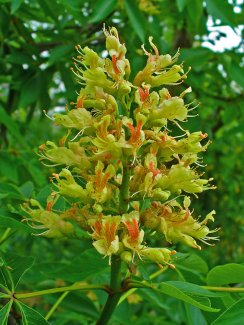Northern America
North-Central U.S.A.: United States - Illinois, - Iowa, - Kansas, - Missouri, - Nebraska, - Oklahoma
Northeastern U.S.A.: United States - Indiana, - Michigan, - Ohio, - Pennsylvania, - West Virginia
South-Central U.S.A.: United States - Texas
Southeastern U.S.A.: United States - Alabama, - Arkansas, - Kentucky, - Mississippi, - Tennessee
This is a low-branched, small to medium-sized deciduous tree that typically grows 20-40’ tall with a broad oval-rounded crown. Bright green palmate compound leaves emerge in spring, each with five spreading ovate-oblong leaflets to 3-6” long. Leaves mature to dark green in summer. Fall color is usually yellow, although foliage may develop interesting and attractive shades of orange and red in some years. Greenish-yellow flowers (to 1” long) appear in clusters in mid-spring. Flowers are followed by the familiar fruit, which is a globular dehiscent capsule consisting of 1-2 buckeyes encased by a leathery light brown partitioned husk covered with warty spines. Fruit on the tree is interesting but not particularly ornamental. When ripe, each buckeye turns a handsome shiny dark mahogany brown with a light tan eye. All parts of this tree, particularly the flowers, bark and twigs, emit an unpleasant odor when bruised, hence the sometimes common name of fetid buckeye.
This tree is available through most local nurseries. The tree is an attractive ornamental, best in open, natural settings or parks because of its broad crown. It also is sometimes cultivated as an ornamental shrub. Not recommended as a street tree or for use near homes because of the litter produced (particularly twigs, fruit and falling leaves). A good selection for more remote areas of the landscape including native plant and woodland areas.
